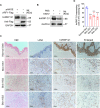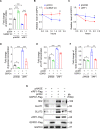A viral interferon regulatory factor degrades RNA-binding protein hnRNP Q1 to enhance aerobic glycolysis via recruiting E3 ubiquitin ligase KLHL3 and decaying GDPD1 mRNA
- PMID: 35538151
- PMCID: PMC9613757
- DOI: 10.1038/s41418-022-01011-1
A viral interferon regulatory factor degrades RNA-binding protein hnRNP Q1 to enhance aerobic glycolysis via recruiting E3 ubiquitin ligase KLHL3 and decaying GDPD1 mRNA
Abstract
Reprogramming of host metabolism is a common strategy of viral evasion of host cells, and is essential for successful viral infection and induction of cancer in the context cancer viruses. Kaposi's sarcoma (KS) is the most common AIDS-associated cancer caused by KS-associated herpesvirus (KSHV) infection. KSHV-encoded viral interferon regulatory factor 1 (vIRF1) regulates multiple signaling pathways and plays an important role in KSHV infection and oncogenesis. However, the role of vIRF1 in KSHV-induced metabolic reprogramming remains elusive. Here we show that vIRF1 increases glucose uptake, ATP production and lactate secretion by downregulating heterogeneous nuclear ribonuclear protein Q1 (hnRNP Q1). Mechanistically, vIRF1 upregulates and recruits E3 ubiquitin ligase Kelch-like 3 (KLHL3) to degrade hnRNP Q1 through a ubiquitin-proteasome pathway. Furthermore, hnRNP Q1 binds to and stabilizes the mRNA of glycerophosphodiester phosphodiesterase domain containing 1 (GDPD1). However, vIRF1 targets hnRNP Q1 for degradation, which destabilizes GDPD1 mRNA, resulting in induction of aerobic glycolysis. These results reveal a novel role of vIRF1 in KSHV metabolic reprogramming, and identifying a potential therapeutic target for KSHV infection and KSHV-induced cancers.
© 2022. The Author(s), under exclusive licence to ADMC Associazione Differenziamento e Morte Cellulare.
Conflict of interest statement
The authors declare no competing interests.
Figures








Similar articles
-
An oncogenic viral interferon regulatory factor upregulates CUB domain-containing protein 1 to promote angiogenesis by hijacking transcription factor lymphoid enhancer-binding factor 1 and metastasis suppressor CD82.Cell Death Differ. 2020 Dec;27(12):3289-3306. doi: 10.1038/s41418-020-0578-0. Epub 2020 Jun 17. Cell Death Differ. 2020. PMID: 32555380 Free PMC article.
-
Kaposi's Sarcoma-Associated Herpesvirus Viral Interferon Regulatory Factor 1 Interacts with a Member of the Interferon-Stimulated Gene 15 Pathway.J Virol. 2015 Nov;89(22):11572-83. doi: 10.1128/JVI.01482-15. Epub 2015 Sep 9. J Virol. 2015. PMID: 26355087 Free PMC article.
-
Sperm associated antigen 9 promotes oncogenic KSHV-encoded interferon regulatory factor-induced cellular transformation and angiogenesis by activating the JNK/VEGFA pathway.PLoS Pathog. 2020 Aug 10;16(8):e1008730. doi: 10.1371/journal.ppat.1008730. eCollection 2020 Aug. PLoS Pathog. 2020. PMID: 32776977 Free PMC article.
-
Distinct roles of Kaposi's sarcoma-associated herpesvirus-encoded viral interferon regulatory factors in inflammatory response and cancer.J Virol. 2013 Sep;87(17):9398-410. doi: 10.1128/JVI.03315-12. Epub 2013 Jun 19. J Virol. 2013. PMID: 23785197 Free PMC article. Review.
-
KSHV Reprogramming of Host Energy Metabolism for Pathogenesis.Front Cell Infect Microbiol. 2021 May 12;11:621156. doi: 10.3389/fcimb.2021.621156. eCollection 2021. Front Cell Infect Microbiol. 2021. PMID: 34055662 Free PMC article. Review.
Cited by
-
An update on Glycerophosphodiester Phosphodiesterases; From Bacteria to Human.Protein J. 2024 Apr;43(2):187-199. doi: 10.1007/s10930-024-10190-4. Epub 2024 Mar 16. Protein J. 2024. PMID: 38491249 Review.
-
HPV E6/E7-Induced Acetylation of a Peptide Encoded by a Long Non-Coding RNA Inhibits Ferroptosis to Promote the Malignancy of Cervical Cancer.Adv Sci (Weinh). 2025 Mar;12(10):e2414018. doi: 10.1002/advs.202414018. Epub 2025 Jan 21. Adv Sci (Weinh). 2025. PMID: 39836502 Free PMC article.
-
Tailoring an intravenously injectable oncolytic virus for augmenting radiotherapy.Cell Rep Med. 2025 May 20;6(5):102078. doi: 10.1016/j.xcrm.2025.102078. Epub 2025 Apr 14. Cell Rep Med. 2025. PMID: 40233744 Free PMC article.
-
Lactylation of NAT10 promotes N4-acetylcytidine modification on tRNASer-CGA-1-1 to boost oncogenic DNA virus KSHV reactivation.Cell Death Differ. 2024 Oct;31(10):1362-1374. doi: 10.1038/s41418-024-01327-0. Epub 2024 Jun 15. Cell Death Differ. 2024. PMID: 38879723 Free PMC article.
-
m6A-modified circARHGAP12 promotes the aerobic glycolysis of doxorubicin-resistance osteosarcoma by targeting c-Myc.J Orthop Surg Res. 2024 Jan 4;19(1):33. doi: 10.1186/s13018-023-04502-0. J Orthop Surg Res. 2024. PMID: 38178201 Free PMC article.
References
-
- Bannai H, Fukatsu K, Mizutani A, Natsume T, Iemura S, Ikegami T, et al. An RNA-interacting protein, SYNCRIP (heterogeneous nuclear ribonuclear protein Q1/NSAP1) is a component of mRNA granule transported with inositol 1,4,5-trisphosphate receptor type 1 mRNA in neuronal dendrites. J Biol Chem. 2004;279:53427–34. doi: 10.1074/jbc.M409732200. - DOI - PubMed
Publication types
MeSH terms
Substances
Grants and funding
LinkOut - more resources
Full Text Sources

